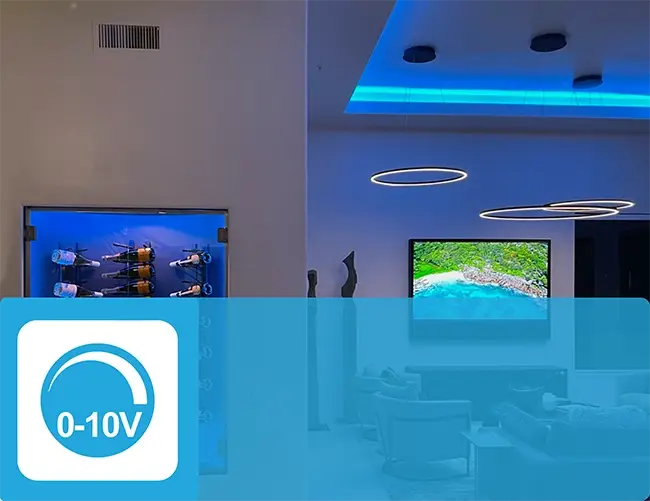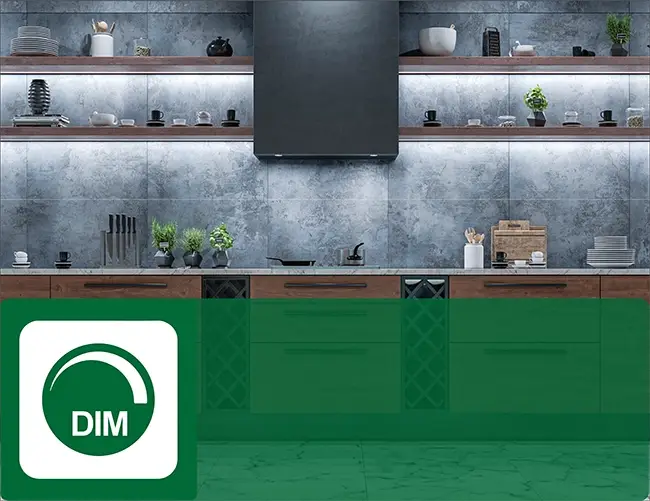In the modern world of smart homes, lighting plays an indispensable role as one of the most important aspects of a living space. Lighting is not just about illumination; it’s about mood, functionality, aesthetics, wellness, and energy efficiency. In this guide, you will learn about the main aspects you need to know when planning the lighting design for your home, from the different types of control systems to how lighting can be efficiently integrated into the architecture and design.
Lighting control has quickly evolved past legacy wiring and into a more digitally addressable age, where a touch panel or app can easily control lighting scenes and room ambiance. These lighting control systems offer different functionalities for your home and are important to consider when developing a lighting design plan for your home. The three common systems are legacy wiring, panelized lighting, and digitally addressable – or RF lighting.
Legacy wiring involves zoning each part of your home individually, having multi-gang switches for fans and lamps, as well as control panels and circuit breakers to handle all the high-voltage electrical systems. Everything must be imagined, planned, and designed before construction, or it can be difficult to change in the later stages of moving into your home – meaning if you want to add more lighting fixtures or change the zones at a later date, it can be costly and difficult to rewire. The switches and controls are all hardwired and addressed to specific lighting zones and configurations. This means each light switch is connected to a single zone, creating multiple switches on a wall in every room. When completely hardwiring a home, the labor can be more intensive and costly.
This system can incorporate smart switches and high-voltage keypads to replace the standard in-wall switches, but it still requires multi-gang switches for the rest of your fixtures – such as fans and kitchen vent lights. Switch options are in-wall dimmers, non-dimming in-wall switches, and high-voltage keypads, although the styles for the latter are limited. Multiple zones per room causes wall-clutter, especially when you must zone all lighting fixtures in a home. Legacy wiring offers phase dimming for decorative fixtures. However, it does not support 0-10V dimming for such fixtures, and there’s no guaranteed dimming performance. We will go more in depth into 0-10V lighting and more things to know about lighting later in this guide.
Panelized lighting solves part of the limitations of legacy wiring. Instead of having switches and dimmers in every room, all the control modules are in a centralized panel. This allows for smart keypads or touch interfaces to replace gangs of switches. Panelized lighting simplifies complex lighting systems, reduces wall clutter from switches to engraved keypads, and offers an all-in-one solution for whole-home lighting control. But still requires all lighting design and wiring to be done during construction, is labor intensive, and can be tricky to change.
RF Lighting is the contemporary option for luxury homes. RF – or digitally addressable lighting, reduces the need for complex wiring systems and provides more flexibility in terms of placement of fixtures and light control at any time, pre or post construction… Even after you move into your home.
Digitally addressable lighting control offers remote control functionality and the ability to address each bulb in a room, versus the need to control entire zones and rely on a single switch for it. How you divide the zones and which button will control what, you can decide at any time, pre- or post-construction, and you can also easily change it as your needs evolve. This system takes up less space on your walls, does not need large control panels or multi-gang switches, requires less labor, and has a more expansive limit on capabilities the lighting fixture itself can do. It reduces the complexity of hard wiring by zones and switches, and all you need to do is bring power to the fixture.
The control resides in the bulb or fixture, which means you can control any light via a keypad, touch panel, or app. This opens up the ability for sleek, low-voltage (wireless) keypads with a multitude of options and possibilities for personalization. This design not only eases installation in new constructions but also offers a hassle-free retrofit option for existing homes, eliminating the need for major rewiring.



0-10V Lighting is the dimming control system often used for commercial and residential LED fixtures. The “0-10V” terminology refers to the range of voltage that’s used to control the light level: 0V corresponds to the light being off, and 10V corresponds to the light being at its maximum output.

Dimming is the adjustment of light intensity. Ketra lighting, for example, can go from 100% to .1% with a warm dim capability, mimicking candlelight. Other LED bulbs can only go down to 5% or 1% dim and cannot warm dim. Also, Ketra lights mimic the dimming behavior of incandescent bulbs, offering a warming effect as they are dimmed. Ketra’s standout features include its ability to provide a vast range of whites and saturated colors, including mimicking the light and color of candlelight as mentioned above. This, combined with dimming, allows for unparalleled mood-setting capabilities in residential spaces. Another benefit of Ketra’s dimming capabilities is the ability to enhance comfort or ambiance and reduce eye strain.

LED lights, especially those from Ketra, offer a spectrum of color temperatures, empowering designers to shape the environment of each spot where the light is aiming to. From recreating the intimate low lights of a theater to emulating the golden warmth of a sunset or even the bright clarity of midday sunlight – Only Ketra’s smart bulbs provide a “full spectrum of light” for any moment. Ketra LED Lights come with a wide color spectrum – 1400k to 10000K, with a high CRI and limitless color options. LED lights can be programmed to imitate daylight and aid circadian rhythm.
Another factor to consider is the beam angle, as it influences how light is cast on artwork or walls, while trim sizes and designs ensure that fixtures integrate seamlessly into your space.
Ketra and Lutron offer versatile trims, so you can change the trim to suit your needs, even after the fixtures are put into the walls and ceiling. LEDs, with their slim profile and adaptable design, offer creative lighting possibilities, blending effortlessly into architectural elements for unique and flexible lighting solutions.
Serving as space’s primary light source, ambient lighting ensures visibility and safety, with even distribution being key. Utilize fixtures such as ceiling-mounted lights and pendant lights, adjusting brightness according to the room’s purpose.
Used to highlight specific objects or areas, accent lighting adds depth and dimension to a space. Employ fixtures like track lights and recessed lights and ensure they are positioned to maximize impact while minimizing glare. Brightness levels should notably surpass surrounding lighting.
Tailored for specific activities like reading or cooking, task lighting prevents eye strain and enhances precision. Task lighting examples are adjustable fixtures like desk lamps and under-cabinet lights, positioning them to illuminate the task area directly without casting shadows.
You can combine and layer these lighting types to cater to your space’s functional needs and aesthetic preferences. Integrate balance, functionality, flexibility, and harmony, ensuring that the lighting layers create a cohesive atmosphere adaptable to various moods and activities. For instance, balance task lighting at a vanity with ambient lighting in a bathroom or mix all three types in a bedroom for a complete solution.
Now that you have an idea of the electrical planning and lighting possibilities involved with designing and constructing your lighting plan, it is time to go over what can be included in the lighting packages BTA offers.
Downlights, also known as recessed lights or “can” lights, are fixtures installed into hollow openings in ceilings. Downlights cast light directly downwards, providing targeted illumination that’s ideal for accenting specific areas or objects. Suitable for various applications in any space of your home.
Exterior cove lighting is a form of indirect lighting where the source is hidden, and light is directed towards a ceiling or wall to produce a soft ambient light that can outline the shape of structures. Its primary benefits include:
• Enhancing architectural features.
• Providing safe and subtle night-time illumination.
• Adding aesthetic appeal and highlighting property boundaries.
They can be used to provide accent, task, or general lighting and are often chosen for their energy efficiency, longevity, and uniform illumination.
• Ideal for pathways, driveways, and garden borders.
• Increases outdoor visibility and safety.
• Offers a modern and streamlined look.
Placed within built-in recesses, ledges, or valences in ceilings, or high on walls to provide indirect illumination. The light from the cove is usually directed upwards towards the ceiling or wall, creating a soft ambient glow.
• Creates an ambiance, especially in living rooms and bedrooms.
• Adds depth and layers to interior spaces.
• Reduces glare and offers a diffused light source.
This refers to a specific type of architectural lighting installation where linear LED fixtures are seamlessly integrated into the architecture of a space, giving a clean and unobtrusive look. “Mud-in” essentially means that the lighting fixture is installed in such a way that it’s flush with the surface, and drywall mud (joint compound) is used to cover and blend any edges or seams, making the fixture almost disappear when turned off.
• Offers a sleek, minimalist aesthetic.
• Ideal for modern and contemporary interiors.
• Enhances architectural details without visible light fixtures.
These are task and accent lights primarily used in kitchens and bathrooms to accent above and below cabinets as well as adding decorative features for over counters or under cabinets for safety.
• Enhances kitchen workspaces by illuminating countertops.
• Highlights cabinetry and adds depth to kitchen design.
• Toe-kick lighting provides soft, low-level illumination, perfect for nighttime navigation.
Installed at the base of cabinets, especially in kitchens and bathrooms, toe kick lighting serves as a decorative feature and a safety measure. It can light up the floor, making nighttime navigation easier without turning on bright overhead lights. Outdoor toe kick lighting is pertinent for outdoor safety, especially if you have steps in the front or the back of your house.
• Enhances safety by illuminating floor levels.
• Adds a luxurious touch to interiors.
• Can make spaces appear larger.
Focuses on the space beneath cabinetry. Positioned beneath upper cabinets, this lighting illuminates countertops, making tasks like cooking and reading recipes easier. It can also serve as night lighting for kitchens.
• Illuminates areas dedicated to tasks, such as in kitchens.
• Reduces shadows created by overhead lighting.
• Enhances the color and sheen of countertops.
LED Lighting is rapidly evolving and becoming a common demand in luxury homes, reshaping modern interior design and playing a critical role in determining the functionality, aesthetics, and ambiance of living spaces. BTA’s extensive range of lighting packages, complemented by innovative solutions from renowned brands like Lutron, Ketra, DMF Lighting and Proluxe ensures a seamless integration of style, comfort, and efficiency. Modern LED lighting solves issues associated with outdated traditional lighting systems and comes in versatile functions, features and design types. Get started on your home’s lighting plan with our expert team of integrators at BTA.